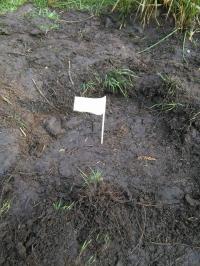The experiments
What have I done and How

As mentioned in the aims, in my thesis I wanted to study the consistency of hand preference across different tasks. Four of the tasks that I included in my study, were tool use tasks familiar to the chimpanzees which they already knew how to perform when I arrived to the zoo. These were the extraction of honey from the hanging trunk, the extraction of honey from an artificial termite mount (see Subjects section), the extraction of honey from a PVC tube and the extraction of nuts through a maze from a feeding device. To study hand preferences, I video recorded these tasks and determined the number of uses of the left and right hands every time an individual performed the task.
As you might remember, two of the tasks I wanted to test (manual and tool digging) had never before been observed directly, so the chimpanzees had to be "guided" in order to perform them. First of all, during the first week, I performed a pilot study in the outdoor enclosure in which I dug holes where I placed a treat (normally grapes) and which I marked with a flag made with a bamboo skewer and a yellow memory sticker. The chimpanzees were really fast on getting the grapes when released to the outdoor enclosure and associated the flags with the presence of food.
After 7 days doing these trials, I started buring food in five locations in the study area, marking them with flags. Afterwards, I recorded them digging to extract the grapes to determine the number of uses of each hand every time they dug.
Josefine and Yr digging together
One of the old females and the infant dig together while Jane, the mother of the infant, sits nearby
Julius and Junior taking part in the digging experiment
The alpha male (left) and his son (right) dig in two of the marked spots where I buried food earlier that day
Responsible for this page:
Director of undergraduate studies Biology
Last updated:
